
The Bottom Line
Introduction & A History Lesson
After over six months of teasing and putting out bits and pieces about their next-gen Polaris architecture, AMD is finally here with the release of their first video card release for the consumer market (not counting the Radeon Pro Duo) with the Radeon RX 480. The release of the Radeon RX 480 is a huge deal for the company, as this is the first consumer video card released under the not-so-newly formed Radeon Technologies Group - with the GPU division of AMD forming RTG late last year.
Since then, they held an RTG summit in Sonoma, California last year that we attended, where we were introduced to the Polaris architecture. At the time no one knew that AMD would move into a new naming scheme, with the previous Radeon R7/R9 nomenclature dropped for the easier Radeon RX family of cards, starting with the RX 480.
I promised a more personal approach to my reviews around a month ago, so here we go. I'm a technology junkie. I don't spend my money on cars, or gambling, or anything like that - I grew up spending my money on hardware. AMD has been a company close to my heart since day one, just like NVIDIA and Intel. I hold no bias towards any company as all companies have something exciting to release. And while AMD has been struggling of late, I believe that the new Radeon RX 480 is a huge, huge change for the company - and this is something that excites me beyond words.
A History Lesson
For what feels like forever, AMD has impressed with releases like the Radeon 9700 PRO, the Radeon X1800 XT - and more specifically the X1800 PRO, which could have its 12 cores unlocked to 16 cores, effectively making it the more expensive, and faster X1800 XT. From there, the HD 5870 was a huge deal at the time because of the collaboration with EA and DICE with Battlefield, and then the Hawaii series being a large smash hit.
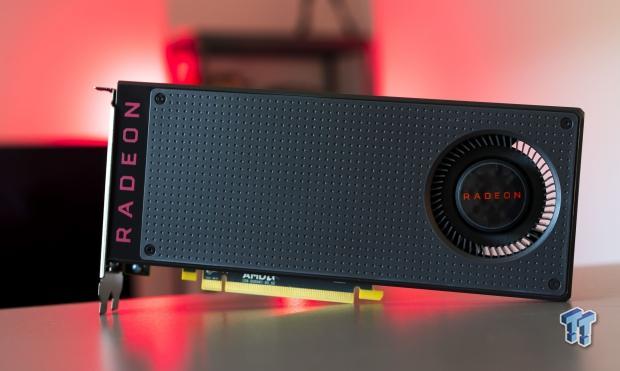
AMD's Hawaii architecture was released at a perfect time, as it was released at the end of 2014 led by the Radeon R9 290X - and is still a powerful card and impressive piece of architecture, even now. The Radeon R9 290X was a monster, where NVIDIA slapped down their new Maxwell architecture shortly after with the release of the GeForce GTX 980. Where NVIDIA had efficiency on their side with the Maxwell architecture, the Hawaii architecture from AMD proved to be a big deal, and kept legions of AMD fans on Team Red.
In early 2015, AMD released the Radeon R9 295X2 - a dual-GPU video card which like the R9 290X, is still a great card even today. It was the last dual-GPU released for consumers - with NVIDIA only releasing their GeForce GTX Titan Z for the professional market, and AMD with its recent Radeon Pro Duo - which was never destined for consumers.
While AMD has had a spotty past, we have to remember that NVIDIA has as well. Fermi was a mess, a total, hot, and extremely loud mess - culminating in the why-was-it-even-released GeForce GTX 480. This was before my time with TweakTown, but I remember not selling many of GTX 480s in my position at an IT retailer all those years ago. I remember selling boxes and boxes of AMD's Radeon HD 5850 and HD 5870 at the time, but NVIDIA's cards gathered dust.
NVIDIA quickly gathered itself, and launched a totally new offensive - constantly hitting AMD again and again with releases, with their grip firmly attached at AMD's neck with the GTX 980 release. Even more so now with the recent shift to the 16nm FinFET-based GeForce GTX 1080 and GTX 1070, powered by their next-gen Pascal architecture. AMD has traditionally tried to fight NVIDIA at the top, releasing flagship GPU after flagship GPU - and it has either beat NVIDIA, equaled them, or lost to them - but not anymore... at least not until 2017.
Why the history lesson? We need to know where AMD and NVIDIA have been over the last few years, and what AMD's new direction is with Radeon Technologies Group. RTG is now not worrying, at least for now, about the enthusiast market - and is instead hitting the mainstream market hard and fast with the new Polaris-based Radeon RX 480.
AMD Traverses a Sea of Stars With Polaris - Part 1
AMD Bets the Farm on Polaris
I still remember arriving at the RTG event in Sonoma late last year, with its beautifully cold weather and even more beautiful surroundings, and being excited about the new energy that AMD had found itself within the Radeon Technologies Group. It felt like the band was back together, where I felt some of that old, exciting ATI energy once again.
Well, here we are all these months later, and we finally have Polaris in our hands in the form of the Radeon RX 480. What do AMD and RTG want to deliver with Polaris? Let's talk about that.

This market is where 80% or more of gamers spend their money, and this market is filled with gamers who don't have $500+ to spend on a video card. NVIDIA might have the $500+ market owned with its new GeForce GTX 1080, but AMD is aiming at the sub $300 market with its new Radeon RX series of cards, and if they can play their cards right (pun not intended, but it works well), they could start pulling some of that discrete GPU market share back in their favor.

AMD is worried that gamers are being left behind with older architectures, and wants to deliver Polaris and its slew of features and technology to the masses.

AMD knows that around 84% of the market (based on their internal data) buys $100-$300 video cards, which is right where the pricing aligns for the Radeon RX series of cards.
VR is the Future, Period
If you haven't tried out a VR headset yet, you really ought to. I've tried them all, ranging from the DK1 and DK2 headsets from Oculus, all the way through to their first consumer VR headset, the Rift CV1. Personally, the HTC Vive is the winner thanks to its offering of room scale VR, and the PlayStation 4 will soon have PlayStation VR - which is something big for AMD, as the PS4 is powered by an AMD semi-custom design.

Out of the 1.43 billion PCs out there, only 13 million or so will have the GPU chops to handle VR smoothly - which is just 1% of the market. AMD wants to change that with Polaris, in a really big way. But how?

Changing the entry costs of VR is a big step, something that the $199 price on the Radeon RX 480 4GB model will do.
AMD Traverses a Sea of Stars With Polaris - Part 2
4th Generation GCN Architecture Improvements/Features
AMD has had four generations of its GraphicsCore Next architecture, with the first GCN architecture featuring DX11 support, OpenGL 4.2, OpenCL 1.2, hardware tessellation support, and more. As time went on, AMD added new features like DX11.1, DX12, Mantle, Vulkan, LiquidVR, Asynchronous Compute, and Virtual Super Resolution.

The second generation GCN architecture provided improved compute task scheduling, AMD TrueAudio technology, OpenCL 1.2 and OpenGL 4.3 support, and more. It also saw FreeSync support, DX12, Mantle, Vulkan, LiquidVR, Async Compute, and more over time.

The third-generation GCN architecture included support for High Bandwidth Memory (HBM) which was found in the Fiji architecture on the Radeon R9 Nano, R9 Fury, and R9 Fury X cards. The third-gen GCN architecture also included improved tessellation performance, Delta Color Compression, a hardware scheduler (HWS) for Asynchronous Compute, native FP16/Int16 shader ops (APU), and more.


But now we're at the fourth-gen GCN architecture with Polaris, and we have improved geometry processing, LiquidVR API for variable resolution rendering, shader instruction pre-fetch and enhanced buffering, real-time and prioritized Async Compute with spatial and temporal scheduling, and more. AMD has continued to evolve its GCN architecture, which is great to see.
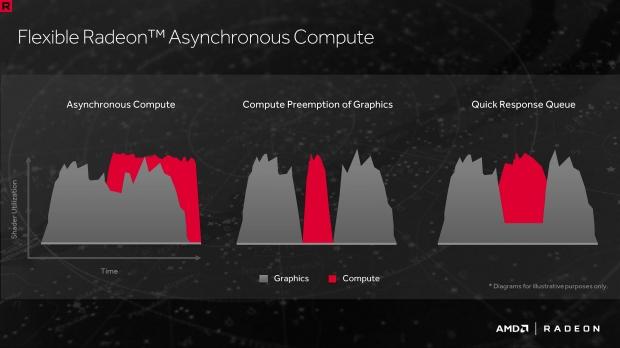
Radeon's Asynchronous Compute support has been extensive.
Polaris 10 & Polaris 11 - Here Are The Specs
Detailed Specifications on the Radeon RX 480

When it comes to detailed specifications on the Radeon RX 480, we have:
- 14nm FinFET GPU
- Polaris architecture
- 36 compute units
- 2304 stream processors
- 8GB GDDR5 @ 8GHz (4GB version @ 7GHz)
- Base clock: 1120MHz
- Boost clock: 1266MHz
- TDP: 150W
AMD Aims for the Mid-Range Market

AMD has split Polaris into two different beasts, with the lower-end Polaris 11 featuring 16 compute units and over 2 TFLOPS in compute performance and we have a 128-bit memory bus. The Polaris 10 is the GPU powering the Radeon RX 480 we have here today, with over double the compute units with 32 CUs onboard. P10 has over 5 TFLOPS of compute performance and has its framebuffer sitting on a 256-bit memory bus.
Now, we're going to get into what other two cards join the Radeon RX 480, with the RX 460 and RX 470 joining the roster - without prices attached to them just yet.

First, we have the Radeon RX 460 - which as you can see, has 14 compute units, 2GB of GDDR5 on a 128-bit memory bus, and no PCIe power connector - it is powered solely from the PCIe port. This is a great solution for eSports and MOBA style games, making it a cost-effective solution for games like Overwatch, League of Legends, or CS:GO.

Stepping up a few notches, we have the Radeon RX 470 - with its increased 32 compute units and 4GB of GDDR5 on a 256-bit memory bus. This means the RX 470 has twice the compute units, VRAM, and memory bus, leading it to require a single 6-pin PCIe power connector. AMD says the RX 470 will be for "brilliant HD gaming," so we should expect console-class graphics (720p to 1080p) with no performance issues.
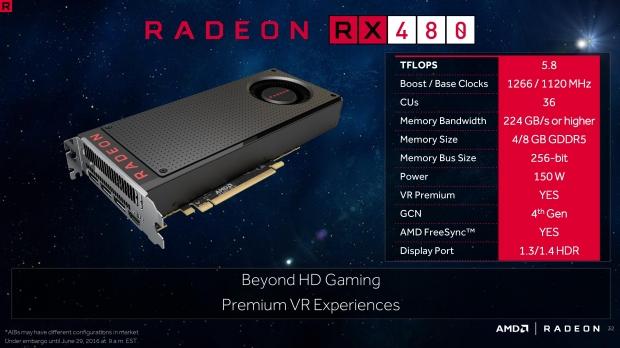
I've saved the best for last, the Radeon RX 480. AMD has splashed down 36 compute units, with either 4/8GB of GDDR5 on a 256-bit memory bus. The Radeon RX 480 is what we have here to review right now, with the 8GB model featuring an 8GHz clock speed on the RAM, while the 4GB model is clocked down to 7GHz.
Detailed Look at the Radeon RX 480
Detailed Look
AMD went with a clean reference design on the Radeon RX 480, something that I love the look of. The RADEON logo doesn't light up, which would've been nice, but this is a $199/$239 (4GB/8GB) card, so I'm OK with that.

The front of the RX 480 looks very similar to the R9 Fury X, while the Radeon logo has been updated - a look that I really love. It's a nice, subtle change to the Radeon logo that goes a long way with the new RTG-powered card.

I didn't think I'd like the look of the blower fan, but I'm definitely a fan of this... uh, fan.

AMD moved to the 14nm FinFET process with the new Radeon RX series, with the RX 480 only requiring a single 6-pin PCIe connector.

The rear of the Radeon RX 480 is bare, without a backplate - and we can see that the PCB itself is actually quite short. It's only a little longer than the Radeon R9 Nano - and that was small thanks to its HBM1 technology, something the RX 480 doesn't have. The cooler extends past the PCB, so I'm looking forward to seeing what the AIB partners can do with that.

Stand tall, Radeon RX 480.

There are no DVI connectors in sight with the Radeon RX 480, with 3 x DisplayPort and 1 x HDMI output.
Testing Methodology & Test Setup Configuration
Testing Method
For the purposes of testing the AMD Radeon RX 480, and for all future GPU reviews and articles, we've changed up our benchmark suite. I've removed Battlefield 4, GRID: Autosport, BioShock: Infinite, and Grand Theft Auto V. In their place, I've got Far Cry Primal and The Division.
I've also added in some DX12 testing, with Hitman and Ashes of the Singularity. This will provide us with enough variety, but I'm on the hunt for new benchmarks all the time. The second that Battlefield 1 drops, we'll be including that in our GPU reviews, while I'll also be keeping an eye out on the release of Deus Ex: Mankind Divided.
Test System Configuration
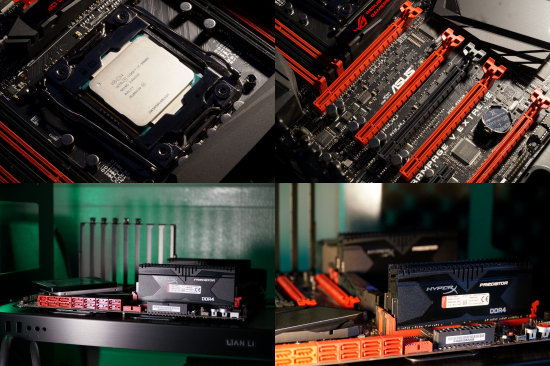
Corsair sent us over their kick-ass AX1500i PSU, which provides 1500W of power for our 3 and 4-way GPU testing that we have coming very soon.
Anthony's Video Card Test System Specifications
- Motherboard: ASUS Rampage V Extreme - Buy from Amazon / Read our review
- CPU: Intel Core i7 5960X - Buy from Amazon / Read our review
- Cooler: Corsair H110 - Buy from Amazon / Read our review
- Memory: Kingston 16GB (4x4GB) HyperX Predator DDR4 3000MHz - Buy from Amazon
- Storage #1: SanDisk Extreme II 240GB - Buy from Amazon / Read our review
- Storage #2: Intel 730 Series 480GB - Buy from Amazon / Read our review
- Case: Lian Li PC-T80 Open-Air - Buy from Amazon
- Power Supply: Corsair AX1500i - Buy from Amazon / Read our review
- OS: Microsoft Windows 10 Home 64-bit - Buy from Amazon
- Drivers: NVIDIA GeForce 368.39 and AMD Catalyst 16..2.2
Benchmarks - Synthetic
3DMark Fire Strike - 1080p
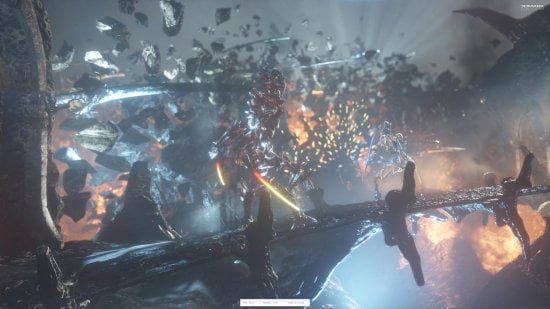
3DMark has been a staple benchmark for years now, all the way back to when The Matrix was released and Futuremark had bullet time inspired benchmarks. 3DMark is the perfect tool to see if your system - most important, your CPU and GPU - is performing as it should. You can search results for your GPU, to see if it falls in line with other systems based on similar hardware.
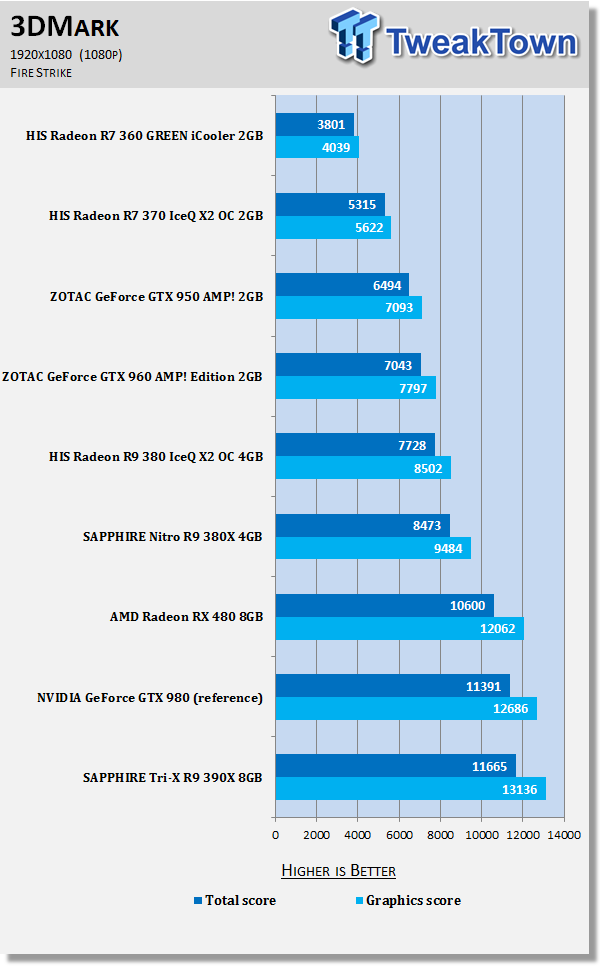
3DMark Fire Strike Extreme - 1440p

3DMark Fire Strike Ultra - 4K (3840x2160)
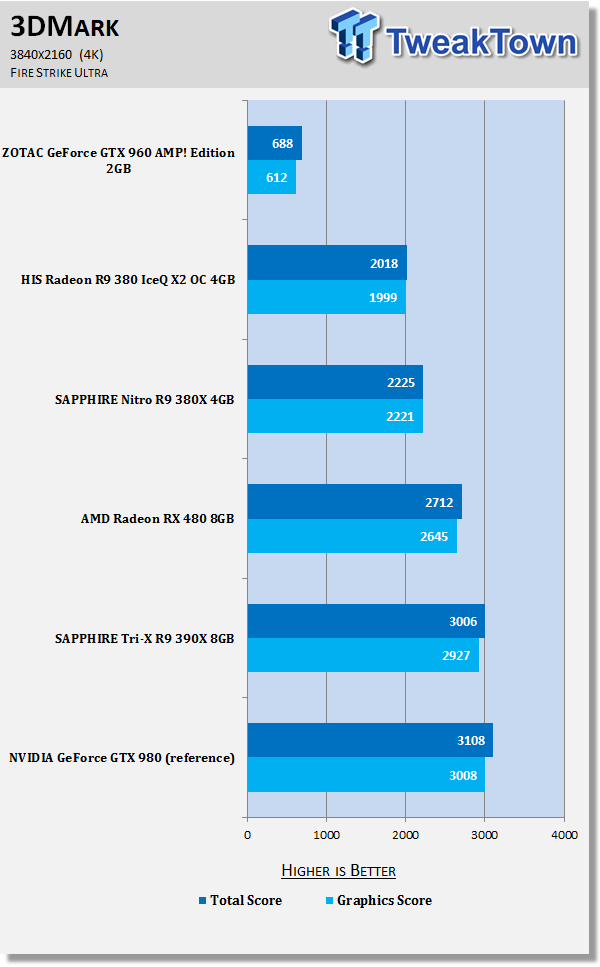
Heaven - 1080p
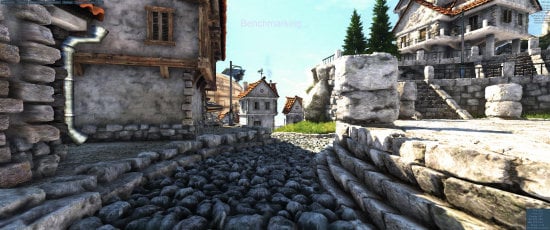
Heaven is an intensive GPU benchmark that really pushes your silicon to its limits. It's another favorite of ours as it has some great scaling for multi-GPU testing, and it's great for getting your GPU to 100% for power and noise testing.

Heaven - 1440p

Heaven - 4K (3840x2160)

Benchmarks @ 1080p
1080p Benchmarks

Far Cry Primal is a game built on the impressive Dunia Engine 2 with wide open, beautiful environments. It might look stunning, but the performance is actually quite good - but most cards will be stressed at 1440p, and especially so at 4K and beyond.
You can buy Far Cry Primal at Amazon.
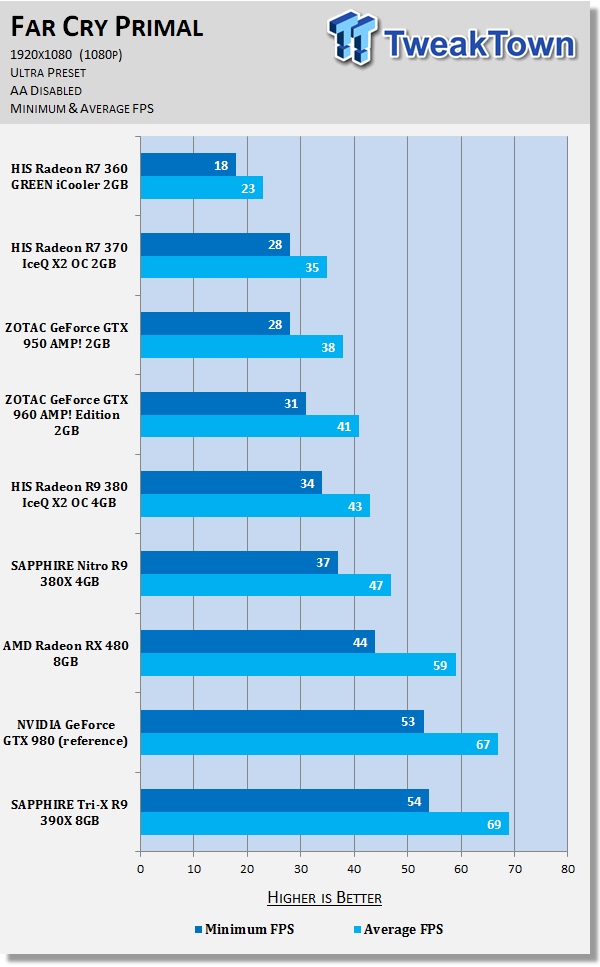

We recently changed over to Metro: Last Light Redux, with developer 4A Games making the Redux version of Metro: Last Light the 'definitive' version of the game. Redux had a fresh coat of paint on the already impressive 4A Engine, and it really pushes our GPUs to their limits.
You can buy Metro: Last Light Redux at Amazon.


Middle-earth: Shadow of Mordor is one of the most graphically intensive games we test, with Monolith using their own Lithtech engine to power the game. When cranked up to maximum detail, it will chew through your GPU and its VRAM like it's nothing.
You can buy Middle-earth: Shadow of Mordor at Amazon.


Thief has been around for quite a while now, with the latest version of the first-person stealth game powered by Epic Games' older Unreal Engine 3. While it's old, it has some great multi-GPU scaling that we use to test out our various GPU setups.
You can buy Thief at Amazon.


Tomb Raider is still such a gorgeous game, with developer Crystal Dynamics using their own 'Foundation' engine to build Lara Croft into the new world. One of the best parts about Tomb Raider is the absolutely stellar multi-GPU scaling, so this is an important test to see how well our NVIDIA GeForce SLI and AMD Radeon Crossfire setups scale.
You can buy Tomb Raider at Amazon.

Benchmarks @ 1440p
1440p Benchmarks

Far Cry Primal is a game built on the impressive Dunia Engine 2 with wide open, beautiful environments. It might look stunning, but the performance is actually quite good - but most cards will be stressed at 1440p, and especially so at 4K and beyond.
You can buy Far Cry Primal at Amazon.


We recently changed over to Metro: Last Light Redux, with developer 4A Games making the Redux version of Metro: Last Light the 'definitive' version of the game. Redux had a fresh coat of paint on the already impressive 4A Engine, and it really pushes our GPUs to their limits.
You can buy Metro: Last Light Redux at Amazon.


Middle-earth: Shadow of Mordor is one of the most graphically intensive games we test, with Monolith using their own Lithtech engine to power the game. When cranked up to maximum detail, it will chew through your GPU and its VRAM like it's nothing.
You can buy Middle-earth: Shadow of Mordor at Amazon.


Thief has been around for quite a while now, with the latest version of the first-person stealth game powered by Epic Games' older Unreal Engine 3. While it's old, it has some great multi-GPU scaling that we use to test out our various GPU setups.
You can buy Thief at Amazon.


Tomb Raider is still such a gorgeous game, with developer Crystal Dynamics using their own 'Foundation' engine to build Lara Croft into the new world. One of the best parts about Tomb Raider is the absolutely stellar multi-GPU scaling, so this is an important test to see how well our NVIDIA GeForce SLI and AMD Radeon Crossfire setups scale.
You can buy Tomb Raider at Amazon.

Benchmarks @ 4K
4K Benchmarks

Far Cry Primal is a game built on the impressive Dunia Engine 2 with wide open, beautiful environments. It might look stunning, but the performance is actually quite good - but most cards will be stressed at 1440p, and especially so at 4K and beyond.
You can buy Far Cry Primal at Amazon.
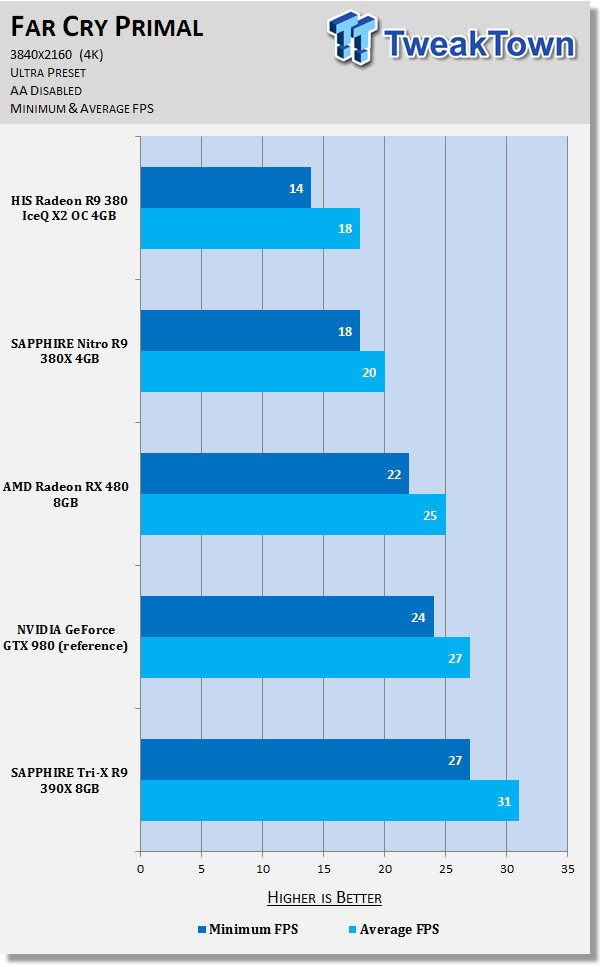

We recently changed over to Metro: Last Light Redux, with developer 4A Games making the Redux version of Metro: Last Light the 'definitive' version of the game. Redux had a fresh coat of paint on the already impressive 4A Engine, and it really pushes our GPUs to their limits.
You can buy Metro: Last Light Redux at Amazon.
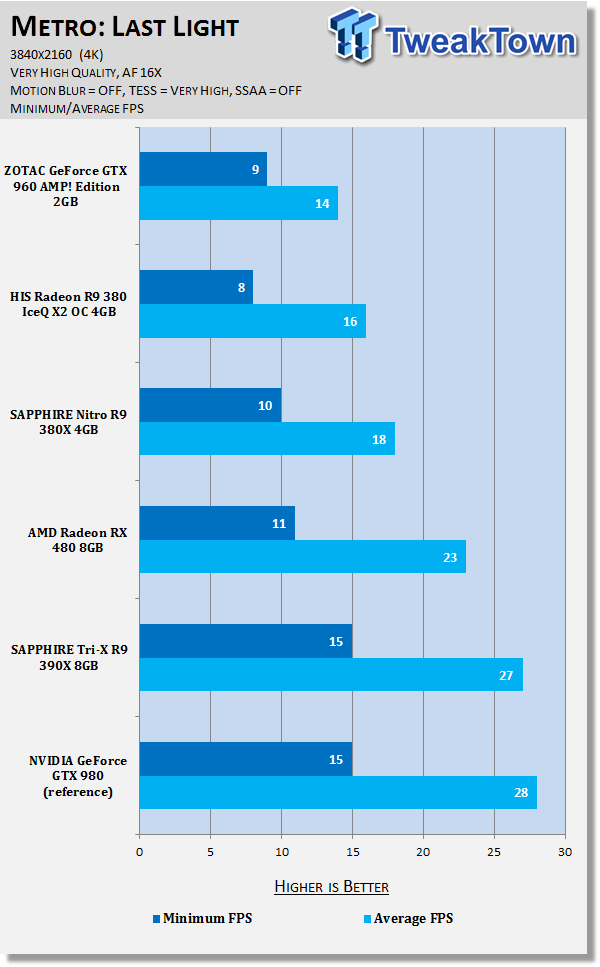

Middle-earth: Shadow of Mordor is one of the most graphically intensive games we test, with Monolith using their own Lithtech engine to power the game. When cranked up to maximum detail, it will chew through your GPU and its VRAM like it's nothing.
You can buy Middle-earth: Shadow of Mordor at Amazon.


Thief has been around for quite a while now, with the latest version of the first-person stealth game powered by Epic Games' older Unreal Engine 3. While it's old, it has some great multi-GPU scaling that we use to test out our various GPU setups.
You can buy Thief at Amazon.


Tomb Raider is still such a gorgeous game, with developer Crystal Dynamics using their own 'Foundation' engine to build Lara Croft into the new world. One of the best parts about Tomb Raider is the absolutely stellar multi-GPU scaling, so this is an important test to see how well our NVIDIA GeForce SLI and AMD Radeon Crossfire setups scale.
You can buy Tomb Raider at Amazon.

Benchmarks - DX12 & OC Adventures
This is our new section for video card reviews, with DX12 and VR becoming a huge deal over the course of the last 12 months. We have just a handful of DX12 tests right now, so expect this section of the site and our reviews to grow considerably over the coming months.
The same goes for VR, where we have both the Oculus Rift and HTC Vive in-house now. We will be testing VRMark for now, which is in Preview form, as well as our thoughts on VR gaming on the HTC Vive with the Radeon RX 480.
DirectX 12 Performance
We have Ashes of the Singularity with DirectX 12, with some impressive results from AMD's new Polaris-based Radeon RX 480 video card.


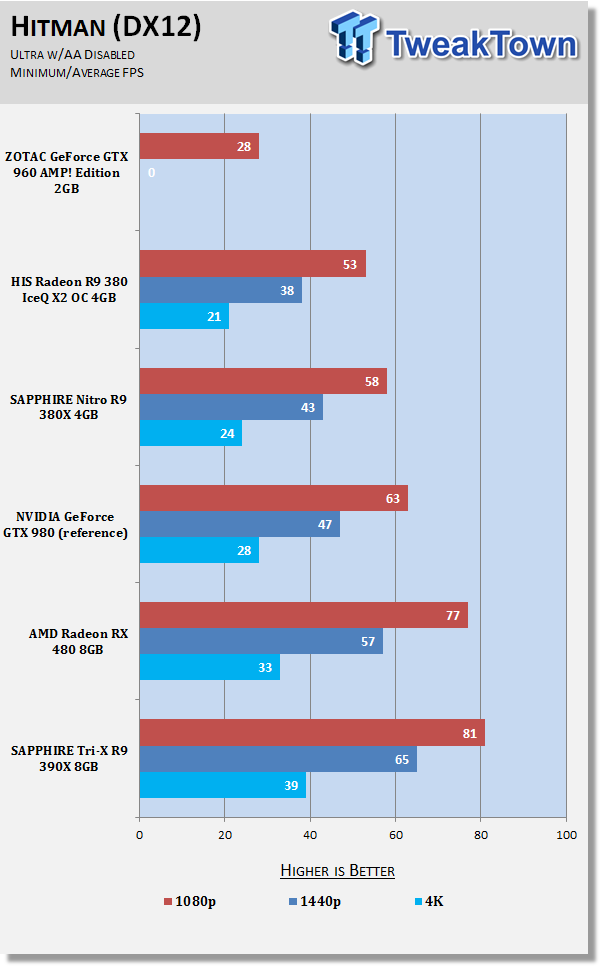
DX12 Performance Analysis
While we might only have Ashes of the Singularity and Hitman for our DX12 testing (for now, we have more games on the way), the new Polaris-based Radeon RX 480 fares incredibly well. If we look at Hitman at 1080p, we can see that the RX 480 isn't too far behind the overclocked R9 390X - and it beats the GTX 980 considerably, too - some great results there for AMD. Even at 4K, the RX 480 beats out the GTX 980 and is just 20% behind the R9 390X - that's damn good considering its nearly half the price.
The same thing goes for Ashes of the Singularity, with the RX 480 holding its own against the GTX 980 and the overclocked Radeon R9 390X from SAPPHIRE. We have 39FPS average, edging out the GTX 980 and its 37FPS, while the overclocked R9 390X blitzes them both with 47FPS average in Ashes.
Overclocking Adventures
In order to get this review out on time, I didn't spend much time overclocking it - and I think it deserves its own separate article, something I'll release in a few days. But, I did some basic overclocking on AMD's latest Radeon RX 480 and hit 1300MHz on the core without a problem, while I was able to hit 2100MHz (8.4GHz) on the RAM.
Sitting at this OC on the RX 480, our total power consumption went from 250W to around 340W while the card became much hotter than it did at stock. While it was overclocked, I played around with manual fan settings - ramping it up to 100% and while the GPU was being utilized to 100%, the GPU hit 66C - even with the fan cranked as high as it'll go.
The AIB partner cards should be much better with both cooling and overclocking performance, so expect some more articles on this part of the RX 480 puzzle in the coming weeks.
Power, Temperature, & Noise
Full System = 250W Under Load!
After reviewing NVIDIA's new GeForce GTX 1080 and GeForce GTX 1070, as well as MSI's GeForce GTX 1080 Gaming X 8G and their GeForce GTX 1070 Gaming X 8G, I expected AMD to fall right in line when it came to power consumption with the new Radeon RX 480.
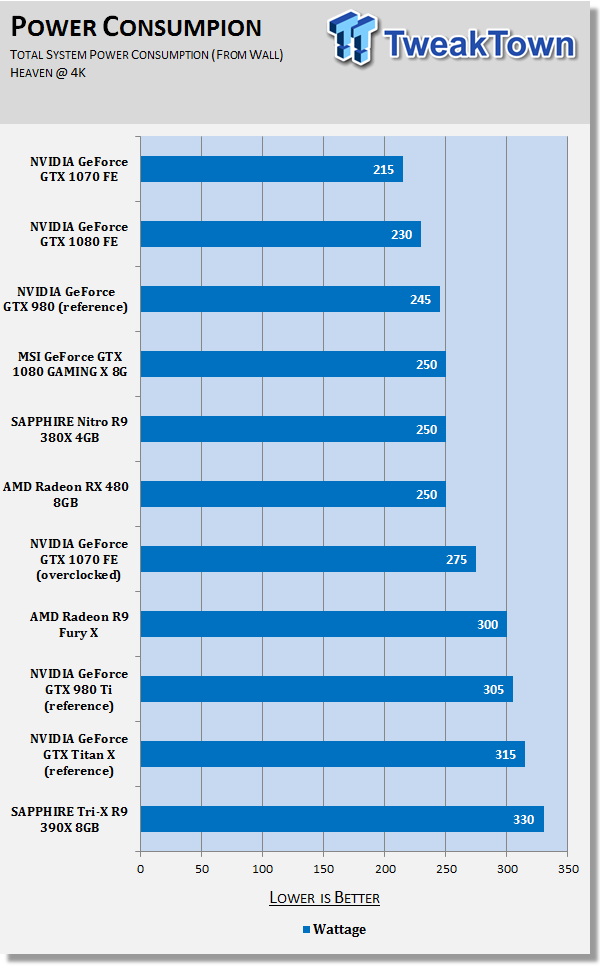
AMD tapped the 14nm FinFET process for its new Polaris GPUs, with our Intel Core i7-5960X test bed with the AMD Radeon RX 480 using 250W total. 250W is pretty good when you consider the 28nm-based, overclocked Radeon R9 390X from SAPPHIRE saw our system use up to 330W. But if we compare it to the new GeForce GTX 1070, which easily beats the RX 480 in every single test, and only consumes 215W, the RX 480 isn't anywhere near as efficient as NVIDIA's new Pascal-based architecture.
Temperature & Noise
I expected AMD's new mid-range Radeon RX 480 to be completely silent under load, but I was disappointed with the reference design from the company. While it rocks a slick reference design, the cooler has a weird sound/whine when it's spooled up to keep the card cool. I tried adjusting the fan speeds and getting a custom RPM set, but as soon as it spins up, the card begins making noise that can be annoying.

With the fan manually set to 100% and a benchmark running using 100% of the GPU, the Radeon RX 480 operates at around 66C average. This isn't too bad, but NVIDIA's GeForce GTX 1070 and GTX 1080 cards don't make anywhere near the same noise or run anywhere near as hot with the fans pumped to 100%. The RX 480 reaches 89C under load on its own, with everything set to automatic - which is quite hot.
Even sitting idle in Windows, the Radeon RX 480 gets hot - so much so that taking it out of the system I expected it not to be hot and nearly hurt my hand from the heat. It wasn't sizzling hot, but it was rather warm - uncomfortably warm for a card that wasn't being strained at all. The card was operating at anywhere between 75C to 80C at idle, with the fan speed at around 20% (automatic).
But as I always say, while you're gaming, you're not going to notice the noise. I have to write about it obviously, but you're going to have headphones or speakers on when gaming with this card - so it shouldn't be an issue. Alternatively, the AIB partner cards should be virtually silent compared to AMD's reference Radeon RX 480 board.
VR for the Other 99% - But is it Future Proof?
Note: The following page handling the VR side of the Radeon RX 480 was written by our resident VR Editor, Jason Evangelho.
Is AMD's New Radeon RX 480 Ready for Mainstream VR, and Beyond?
AMD is putting considerable effort into promoting VR. After all, the more widely VR is adopted, the more potential there is for the cost of entry to get driven down. And the more hardware AMD can sell to consumers, content creators, and game developers. Everyone wins.

The RX 480 is AMD's bid to bring what it calls "Premium VR" to the masses. Prior generation video cards that were deemed "VR Ready" by Oculus and HTC launched at $329, and the RX 480 starts at only $199. Can it deliver an identical VR experience, though? Can it crank out a smooth 90FPS per second, which is crucial not just for enjoyment in virtual reality, but also for comfort?
The great news is that Oculus has officially certified the RX 480 as Oculus Ready for the CV1 Rift, and they have incredibly strict testing procedures. HTC even threw in an endorsement, and the two major players behind desktop-class, premium VR singing your praises certainly helps AMD's cause.
My task, then, was simple: put the Radeon RX 480 through the paces in VR, using an entry-level system that still meets the recommended requirements for VR. Here's what I have lovingly dubbed "The People's Bench" since it represents the more realistic side of gaming, not what's only attainable by people with money to burn.
- Intel Core i5-6400 CPU (Skylake)
- ASUS Z170-A Motherboard
- G.Skill Ripjaws V 16GB DDR4 2400MHz
- VisionTek GO Drive 120GB SSD
- Western Digital Black 1TB HDD
- Corsair RM1000 Power Supply
- Lian Li Pitstop T60 Aluminum Test Bench
We're sort of in the wild west of VR benchmarking right now. Anthony and I are in the process of developing reliable, stable benchmark routines for VR, but in the meantime, we welcome your feedback! The problem is that there are no adequate tools to properly evaluate it because it's not just frame rates that matter. It's motion-to-photon latency, it's frame times. For now, the two best tools at our disposal are pretty much FRAPS and careful user observations. Are frames dropping? Is there judder? Are physical actions relayed to the game instantly?
Using these tools, I had to ask myself a simple question: does the Radeon RX 480 consistently deliver the coveted 90FPS? And even if it doesn't, am I still having an enjoyable, comfortable VR experience?
So, I busted out my CV1 Oculus Rift and took the following mixture of games and non-interactive software for a test drive on the RX 480: Anshar Wars 2, Apollo 11 Experience, Chronos, Oculus Dreamdeck, Edge of Nowhere, EVE Valkyrie, Henry, Into The Dead, Lucky's Tale, and The Climb.

The results were promising, proving that AMD can deliver that premium VR experience at $199.
Apollo 11, Anshar Wars 2, Edge of Nowhere, Oculus Dreamdeck, Henry, Eve Valkyrie, and Lucky's Tale all delivered a rock solid 90FPS, with about the lowest average frame times you can expect at 11.1ms. Into The Dead, Chronos, and Crytek's The Climb couldn't quite maintain an average of 90FPS, dropping down to anywhere between 83FPS and 88FPS, with 99th percentile frame times at between 20ms and 22ms.
That being said, it was impossible to notice those missing frames with the naked eye. I only experienced a case of judder once during Into The Climb, and the rest of the games ran smoothly, resulting in zero nausea or discomfort. And remember, I was actively playing these - they weren't static benchmarks.
If you're sensing a "but," interrupting our praise-fest, here it is. The SteamVR Performance Test concerns me.

It concerns me for a couple of reasons. First, while we see Radeon RX 480 gaming performance pretty much on par with the Radeon 390, VR performance lags slightly behind. Notice how the quality graph shows the Radeon 390 spending more time in the "Very High" section? This is because the test doesn't behave like regular benchmarks. It adapts the quality settings on-the-fly based on your system's performance to deliver that coveted 90FPS.
Second, it's that fact that gives me pause when asked to recommend the RX 480 for first-time VR users. See, AMD is pushing the RX 480 as a GPU to experience premium VR, but they're also pushing the idea of it being somewhat future-proof, mentioning that they want to respect the user's investment. But will the RX 480 be viable next year when the second generation of Rifts and Vives inevitably hit the market, and developers keep pushing the visual envelope forward?
If a very select few games can't maintain a rock solid 90FPS at 100% of the time, will users get to play everything in the virtual reality playground in the next six months? 12 months? 18 months? By adding a second RX 480 into the mix, I'd say probably, but the mainstream consumer market isn't exactly the target market for Crossfire configurations.
For VR, today, the RX 480 is fantastic at the price. Make no mistake about that! But I think patience is the right call here. Adopt a wait-and-see attitude to see what NVIDIA's forthcoming GTX 1060 has up its sleeve, and what price tag it'll carry with it.
#BetterRed & Pricing Comparison
AMD Finds Itself in a New Position
The release of the Radeon RX 480 puts AMD in an interesting position. First, the company has finally released a new consumer-focused video card on the new Polaris architecture, and it's the first consumer launch of a video card since the release of the Radeon R9 Nano in September 2015. It's an exciting time for video cards in general, with VR taking off through the likes of the Oculus Rift and HTC Vive, as well as NVIDIA's new GeForce GTX 1080 and GeForce GTX 1070, along with a slew of partner cards that offer exciting cooling setups, and even more performance.

Secondly, AMD is not competing with the new GeForce GTX 1080 and GTX 1070 which are far more powerful; instead, it is laser focused on the mainstream - wanting to hit the sub $200 market, as well as reposition itself within the VR ecosystem. This is the first time that I can remember AMD not releasing an enthusiast card first, and then trickling out the slower cards in the series.
Last year, AMD debuted the first card with High Bandwidth Memory technology with the Radeon R9 Fury X, with its new Fiji architecture, HBM1 memory, and water cooling by default - AMD still couldn't topple NVIDIA's best cards at the time. NVIDIA continued to hit AMD down with its GeForce GTX 980 Ti and Titan X video cards, even with their GDDR5 memory that couldn't match the 512GB/sec that HBM1 offered on the Fury X, beat AMD in both performance - and even sometimes price/performance per dollar. Especially in 4K gaming, which is where AMD positioned its then high-end and not enthusiast/flagship card - the Radeon R9 380X, as it had 8GB of framebuffer - compared to the piddly 4GB, albeit HBM1, on the Fury X.
Most gamers expected AMD to release a Fury X successor on the exciting new 14nm FinFET process and Polaris architecture until earlier this year - when AMD began its Rebellion against the Empire - the Empire being NVIDIA in this case, by announcing its intentions on the mid-range market. At the time, I remember most gamers, friends, and people commenting online through our comments on Facebook, our articles, Reddit, other sites, and tech YouTuber's comments that they weren't looking forward to AMD's mid-range card.
Then something changed. The tide shifted, and the Rebellion began.
Team Red supports had increased, and the mid-range market became something that they cared about - because AMD had shifted, and altered its image in consumers' minds. I constantly ask gamers, my local Australian friends, and family, and my many industry friends questions on which card they like or think is better - as it helps me judge the overall market, not just the product that happens to be on my test bed.
I've done this for years, as I did ten years of IT retail sales selling these exact parts and many other components to build cheap $600 PCs, right up to custom rigs worth $8000 or more. I like to know the opinions of consumers and gamers in the real-world, as it gives you a better idea of where things will be in a year or two. AMD has repositioned its image with gamers and consumers with the Radeon RX series, changing its entire marketing strategy from top to bottom - at least as much as they can do without somehow creating a totally superior product at the same price - which is impossible.

But with the Radeon RX 480, the company has a card it can push to the masses - not just the smaller market for people who spend over $300 on a video card. NVIDIA has positioned itself as the company you go to if you want something powerful and ready for next-gen games at over 1080p - such as 2560x1440, 3440x1440 on the 21:9 UltraWide monitors, and 4K.

AMD is positioning the Radeon RX series, and right now the RX 480, at the 1080p and VR gaming markets. This is where the mainstream audience is found, with tens of millions of gamers that are potential customers. AMD wants the gamers who are using older video cards that are less power efficient, nowhere near as powerful, and don't have the impressive list of technology and features that the new Polaris-based Radeon RX series have.

The new fourth-generation GCN architecture continues its support with FreeSync and DX12, but adds things like AMD TrueAudio Next, and improved Asynchronous Compute. You can feel safe in buying a new FreeSync monitor right now with a new Radeon RX 480, or waiting a few months and grabbing one of the new 1080p 240Hz or 4K 120Hz displays that are on their way thanks to the additional bandwidth of DisplayPort 1.4 on the RX series cards.
Pricing - AMD Nails the $200-$350 Market
I decided to compare a larger amount of cards priced up to, and just over the $239 price on the Radeon RX 480 8GB card at 1080p - while our 1440p and 4K testing dropped a few of those slower cards, especially since they only had 2GB of VRAM. The cards I tested, were listed on Amazon at the following prices (and obviously at the time of writing):
- HIS Radeon R7 360 GREEN iCooler 2GB - $152.99
- HIS Radeon R7 370 IceQ X2 OC 2GB - ~$150
- ZOTAC GeForce GTX 950 AMP! Edition 2GB - $159.99
- ZOTAC GeForce GTX 960 AMP! Edition 2GB - $208.32
- HIS Radeon R9 380 IceQ X2 OC 4GB - ~$180
- SAPPHIRE Nitro R9 380X 4GB - $248.99
- SAPPHIRE Tri-X R9 390X 8GB - $429.99
- NVIDIA GeForce GTX 980 4GB (reference) - $412 (MSI ARMOR listing on Amazon)
So let's directly compare the Radeon RX 480 4GB at $199 and the 8GB at $239 against the most expensive cards we're testing - the R9 380X 4GB, R9 390X 8GB (both overclocked models) and the reference GeForce GTX 980 from NVIDIA. The Radeon RX 480 has some great sides to it, such as it being smaller, lighter, more power efficient (the GTX 980 uses 5W less) and has support for all the latest technologies like DX12, FreeSync, Async Compute, and more.
If we compare them at 1080p, the RX 480 in Far Cry Primal sits perfectly at 59FPS average - right on the 60FPS average we want to see. Looking at the R9 380X which costs $10 more, and it's beating it by 25%. The RX 480 loses to the 390X and GTX 980, but they're both considerably more expensive - by at least $150 more. Even in something like Metro: Last Light Redux, the Radeon RX 480 beats the overclocked R9 380X by 26.5% - and loses to the overclocked R9 390X card from SAPPHIRE by 15%, and to NVIDIA's GeForce GTX 980 by 22%.
In a game like Middle-earth: Shadow of Mordor where the framebuffer is squeezed to its limits, the GDDR5-based Radeon RX 480 still held its ground. Comparing it against the very similarly priced, and overclocked R9 380X, we have the RX 480 coming out on top by a huge 30% in Shadow of Mordor at 1080p. The GTX 980 is just 8% faster, while the overclocked R9 390X is 11.5% faster. They may be 8% and 11.5% faster, but they also cost close to twice the price of the RX 480.
Final Thoughts
Final Thoughts... Finally
I kept writing and writing in those last couple of pages, and had to expand them into their own sections because they began to get so pumped full of words... but here we are, at the final thoughts on AMD's next-gen Radeon RX 480. It's finally here, and it's actually pretty damn good. Sure, it's not perfect - and it could be better in various areas, something I'll go into detail about soon - but it's a damn good release because of the price.

The entire reason the RX 480 is making waves is the $199 pricing on the 4GB model at least, while the 8GB model is $239. Now you're sitting there thinking, "but Anthony, you didn't test the 4GB model, you tested the 8GB model" - and you're right. But, AMD provided the press with a vBIOS to flash the RX 480 8GB down to the 4GB model - also reducing the clock speed on the RAM from 8GHz on the 8GB model, to 7GHz on the 4GB model.
I did testing at all resolutions and found just 1-2 FPS difference in nearly everything, except for a few like Hitman in DX12 with ~5FPS more average at 1440p for example. For the most part, there's no huge change in performance between the 4GB model and its 7GHz memory, and the 8GB model and its 8GHz memory. This is both good and bad.
The good, is that you can buy the $199 model and enjoy nearly all of the performance we've seen here today - within a few FPS of the benchmarks I've got here. With some overclocking, you can get those additional frames without a problem, and even at 4K the performance was only a few FPS more. The bad, is why is there no larger performance increase between the 7GHz and 8GHz RAM when there should be a 10% improvement on average? Maybe we'll see some differences with the partner cards and their additional PCIe power that can let the card stretch its legs.
My entire thought process behind this review was to come from the perspective of owning an older card like an R9 280 or even the R9 370 and whether I'd look at this review and want to buy it - and I would. I would recommend the Radeon RX 480 for people who don't want to spend $400 or more on a video card. It performs beautifully at 1080p with 60FPS easily achievable and has more than enough grunt under its 150W TDP. But also remember, NVIDIA's far superior GeForce GTX 1070 also has a TDP of 150W, so where is AMD's efficiency within the Polaris architecture going if NVIDIA can perform far above and beyond the RX 480 in the same power envelope?
As it stands, AMD has now got the mainstream market in its grasp with the Radeon RX 480. At $199, it represents stellar value for money - with 1080p 60FPS gaming and VR goodness in its reach. 1440p gaming is actually great on the RX 480, too - and with some in-game detail adjustments - gaming at 2560x1440 at 60FPS average will not be a problem. 4K gaming isn't something I'd recommend on the Radeon RX 480 - but just wait a day or two for our CrossFire results, and that might change your mind.

Overall AMD has impressed me with the Radeon RX 480. Even with all of its flaws, it's good to see AMD back in the game with a new video card release under its new Radeon Technologies Group division. Remember that this isn't an enthusiast card and that AMD has its next-gen Vega architecture due out in early 2017. I believe NVIDIA will tighten its grip on AMD between now and then, forcing AMD to play its hand with another card.
Whether this card would arrive as a souped up Polaris 10-based offering in the form of a Radeon RX 490 with increased CUs and more power delivery (6+8-pin) or a dual-GPU with two P10 GPUs making it 2 x RX 480. AMD could do this with 6+8-pin and still keep the TDP under 300W and price it at $499 to compete directly against the GeForce GTX 1080 and its $599-$699 pricing. Right now, AMD is capable of this - and I think we're going to see something new in the high-end market (but not as fast as the Vega-based cards) before the end of the year.
AMD is also pumping considerable time, effort, R&D, and production assistance into their semi-custom chips for Microsoft and Sony's next-gen consoles - which is good for the companies bottom line, but it might take away from the company competing against NVIDIA in the enthusiast arena for a little while - I'd say around 6-9 months or so.
This doesn't distract from the fact that the Radeon RX 480 is a great card for $199, with the partner cards arriving in the coming weeks - we have some on the way already, AMD is only beginning to make its comeback. We still have the release of the RX 470 and RX 460 in the near future - both with unknown prices. If can get their R7 300 and R9 380 series cards out of the channel and push the RX 460 for $129 and the RX 470 for $169 - it could do some real big damage to NVIDIA's lower-end sales of the GTX 950 and GTX 960 which get trounced by the RX 480.
In the end, the Radeon RX 480 is a damn good card, and for $199, AMD should be applauded for changing its direction. NVIDIA could lose some discrete GPU market share from AMD's new RX series cards if it can't hit the market with sub-$250 cards in the coming months. Remember that countless games are coming out in the next few months, and we're only 4-5 months from the massive holiday season of gaming where we should begin to see just how much the RX series impacts the market. Until then...
The Rebellion has only just begun.

